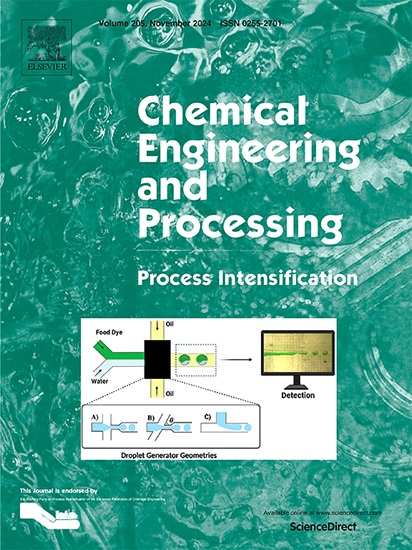Numerical investigations of liquid–liquid extraction through a coiled tube integrated with an extraction outlet
IF 3.8
3区 工程技术
Q3 ENERGY & FUELS
Chemical Engineering and Processing - Process Intensification
Pub Date : 2025-04-21
DOI:10.1016/j.cep.2025.110310
引用次数: 0
Abstract
This study numerically investigates the extraction of two immiscible liquids through coiled tubes integrated with an extraction outlet. Assuming a fully mixed initial state, representing the worst-case scenario, the research explores optimal conditions for achieving pure extraction of each liquid through different outlets. Two laminar Reynolds numbers of 225 and 563, along with seven different outlet split ratios, were analyzed for horizontal-axis coiled tubes. The effects of geometrical parameters and flow conditions on extraction efficiency were examined. For an inlet amine volume fraction of 50%, the results indicate that optimal extraction occurs at a split ratio of 0.5, with enhanced performance at Re = 563 compared to Re = 225. Sharp-edged, constant-diameter extraction tubes outperformed rounded and nozzle-type configurations while reducing the extraction tube diameter diminished the efficiency. Furthermore, an extraction at a coil angle of 675° (2 turns minus 45°) provided better efficiency compared to 765° (2 turns plus 45°). It is therefore recommended to operate near Re = 563, utilize a straight extraction tube with the same diameter as the coiled tube, and employ a sharp-edged connection at a coil angle of 675°. The extraction split ratio should align with the inlet rate of the lighter phase.

带抽吸口的螺旋管液液萃取的数值研究
本研究采用数值方法研究了两种不混相液体通过带萃取出口的盘管的萃取过程。假设完全混合的初始状态,代表最坏的情况,研究探索通过不同出口实现每种液体纯提取的最佳条件。对水平轴螺旋管的两种层流雷诺数225和563以及7种不同的出口劈裂比进行了分析。考察了几何参数和流动条件对萃取效率的影响。当进口胺体积分数为50%时,劈裂比为0.5时提取效果最佳,且在Re = 563时的提取效果优于Re = 225时。边缘锋利、直径恒定的抽油管优于圆形和喷嘴型抽油管,而减小抽油管直径会降低效率。此外,与线圈倾角为765°(2匝加45°)相比,线圈倾角为675°(2匝减45°)的抽吸效率更高。因此,建议在Re = 563附近操作,使用与线圈管直径相同的直抽管,并在线圈角675°处采用锐边连接。萃取分离比应与较轻相的进口速率一致。
本文章由计算机程序翻译,如有差异,请以英文原文为准。
求助全文
约1分钟内获得全文
求助全文
来源期刊
CiteScore
7.80
自引率
9.30%
发文量
408
审稿时长
49 days
期刊介绍:
Chemical Engineering and Processing: Process Intensification is intended for practicing researchers in industry and academia, working in the field of Process Engineering and related to the subject of Process Intensification.Articles published in the Journal demonstrate how novel discoveries, developments and theories in the field of Process Engineering and in particular Process Intensification may be used for analysis and design of innovative equipment and processing methods with substantially improved sustainability, efficiency and environmental performance.

 求助内容:
求助内容: 应助结果提醒方式:
应助结果提醒方式:


